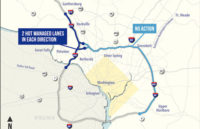The absence of traffic control signs contributed to the fatal March 22 work zone crash along the I-695 Baltimore Beltway, according to an investigation by the Maryland Dept. of Labor.
Two cars, both traveling on the I-695 inner loop in excess of 100 mph—according to Maryland State Police—struck each other. The impact sent one vehicle through an opening of a work zone barrier, where it overturned.
Six workers hit by the out-of-control car were pronounced dead at the scene.
A report issued last month by the agency's Occupational Safety and Health division faulted the Maryland State Highway Administration for not posting proper signage alerting motorists to the movement of construction vehicles around a barrier-protected left-shoulder work zone where employees of Gaithersburg, Md.-based Concrete General Inc. and Sparks, Md.-based KCI Technologies Inc., were working on a design-build congestion management project. The lack of signs exposed workers to “struck-by hazards,” the report concluded.
The Dept. of Labor’s citation, classified as a “serious” violation, carries no financial penalty, but requires the highway agency to take corrective action. In a statement, it asserts that the citation involved “optional” signs for alerting drivers that construction vehicles might be entering and existing the roadway from the left shoulder, and that the incident did not involve a construction vehicle.
The statement went on to say that the signs “would not have prevented the crash from occurring.” The agency will not appeal or contest the citation.
Both motorists involved in the crash are scheduled to go on trial in December on multiple counts of manslaughter, reckless driving and other charges related to the incident. The National Transportation Safety Board’s investigation of the crash also is continuing.
In the months following the I-695 crash, the state formed a work group tasked with examining ways to improve work zone safety via changes in operational set-up, enforcement and driver awareness. Chaired by Maryland Lt. Gov. Aruna Miller (D), a former transportation engineer, the 27-person panel includes highway engineers, law enforcement officials, labor leaders and highway agency staff. Representatives of Concrete General and KCI Technologies also are members.
The work group is scheduled to put forward a comprehensive set of recommended regulatory, executive and legislative actions by the end of the year. Operational recommendations under consideration include state-funded investment in lane-assist and work-zone-intrusion technology, increased maintenance of traffic inspection and auditing resources, additional state police presence in work zones and contractual requirements and incentives for safe practices.
Meanwhile, KCI and Concrete General have resumed work on the I-695 congestion management project, which will use lane controls, intelligent traffic monitoring and other operations technology to convert portions of the highway’s left shoulder into an additional travel lane during rush hours. Scheduled for completion in early 2026, the design-build project includes pavement widening, shoulder rehabilitation and reconstruction, stormwater management and drainage improvements, installation of underground conduit, new signage and pavement markings and lighting improvements.
The highway agency project website identifies several additional traffic calming and enforcement measures around the project work zones to safeguard workers. They include closing lanes adjacent to the median inner and outer loops to create an added buffer from active traffic lanes, reduced speed limits when workers are present and automated speed enforcement systems.




Post a comment to this article
Report Abusive Comment